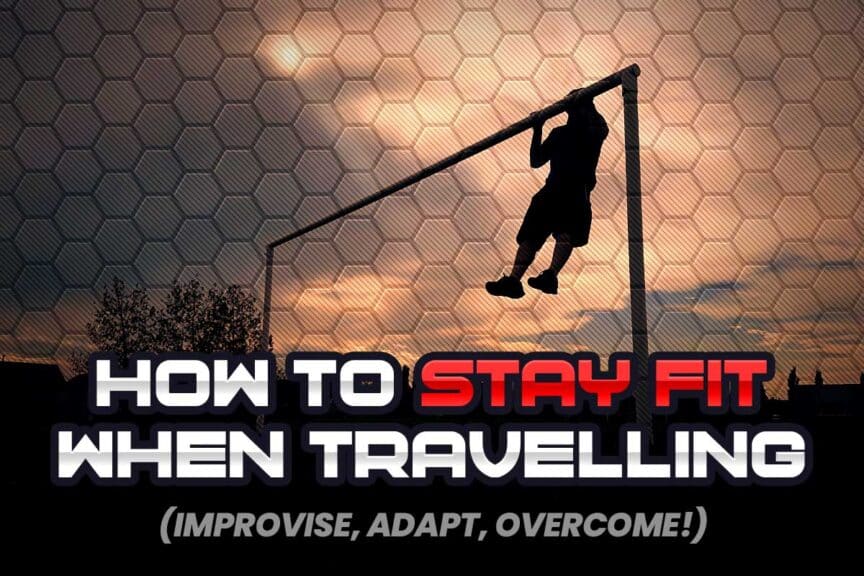I’m currently getting ready to go on a short summer vacation. I’m in dire need of one and greatly look forward to it. And in addition to packing, I’m currently preparing for how I’m going to stay active and get my physical activities in while I’m away.
Being the lifelong fitness enthusiast that I am, I’ve done this numerous times before and am ready to tackle this issue. So, I thought I’d write an article detailing the simple yet highly effective tips anyone can implement to ensure they stay fit and active while travelling.
Here’s the down-and-dirty overview of how to stay fit and active when you leave town for an extended period of time:
You can stay fit and active when travelling by implementing strategic planning, making key changes to your fitness and training pursuits, and being mindful of other aspects of your training. These strategies will take care of the limitations often experienced by individuals when travelling.
Yes, that likely sounds overly simple; however, I will unpack multiple tips within each of these categories below. They’re tips that have worked without flaw for my travels over the years, along with those whom I often train.
The information below is yours for the taking, so read on to learn how to maximize your fitness while you’re out of town!
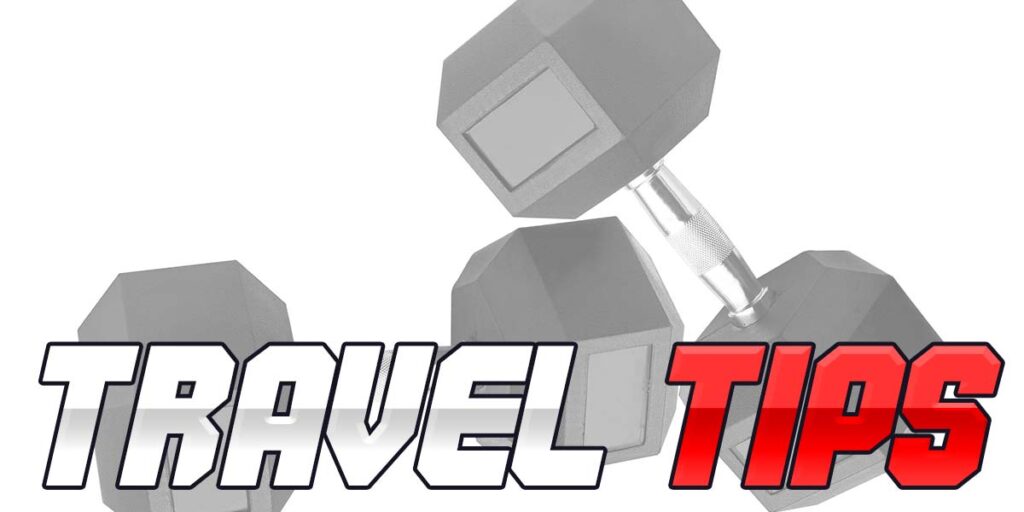
A small request: If you find this article to be helpful, or you appreciate any of the content on my site, please consider sharing it on social media and with your friends to help spread the word—it’s truly appreciated!
Whether it’s work-related or personal travel, most of us will, at some point, if not regularly, find our normal daily or weekly routines disrupted by the need to leave town. While disruptions to our strength training or fitness routines can be annoying, they don’t have to be anything that derails your training entirely.
The tips and strategies below can be beneficial for just about any active individual. They might not be ideal for your exact needs, but the concepts within them can be profoundly helpful for making sure you keep your physical strength, mobility, cardiovascular fitness, endurance, and overall health from regressing while you’re travelling.
So, whether you’re someone who trains for CrossFit, powerlifting, sports, or just recreational activity, take any of the insights below and implement them in ways that work best for you.
And, just in case you’re wondering what the most practical fitness equipment is to bring with you on your trip, be sure to check out my article: Practical Fitness Equipment To Pack When Travelling (Budget Friendly), where I go over some seriously effective and portable training equipment you can bring with you!
Tip 1: Do an extra big workout right before you leave
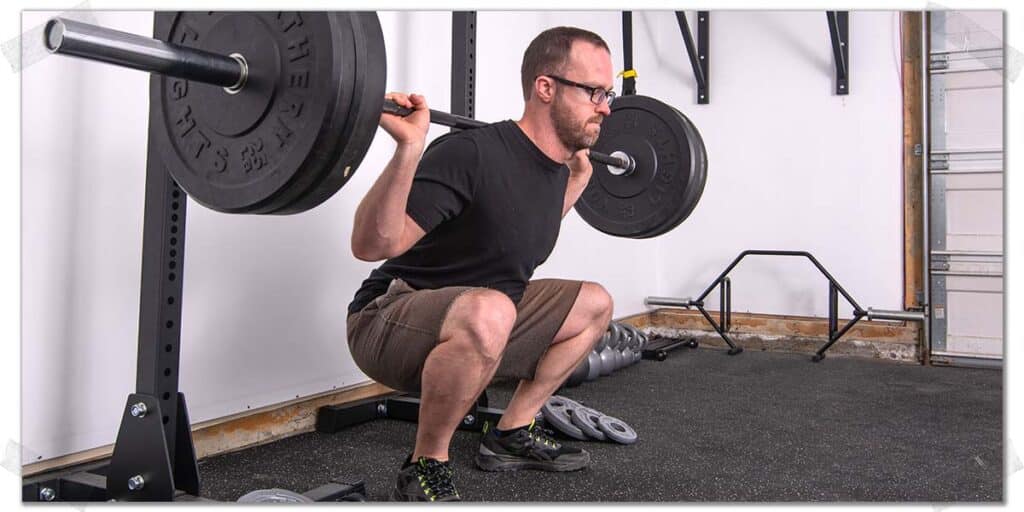
This is an age-old strategy I always strive to implement anytime I’m preparing to leave town for an extended timeframe. If you’re leaving town for a week or more, it’s not going to absolve you from needing to work out throughout the rest of the week, but it will permit you to recover for the first few days of your travels.
By performing a workout that either has more intensity or training volume (number of sets, reps, and/or exercises) a day or two before you leave, your body won’t be idly sitting by for your first day or two of travel. Instead, it will be synthesizing new tissue and recovering from the larger-than-usual stimulus it’s used to receiving.
This comes in particularly handy if you have one or more entire days devoted entirely to travelling (sitting on planes, riding in cars, etc.), which is the time when any type of legitimately structured workout or training session is next to impossible to perform.
Pro tip: If you’re really into training, and you have planned for your trip a long time in advance, you can ramp up your training in the weeks leading up to your getaway (in a process known as accumulation or intensification training), so that you can use the majority or entirety of your time out of town as a de-load or active recovery block in your training calendar.
I’ve personally found that this big workout strategy can help cut out the stress or “guilt” I often feel if I have to miss a workout or training session, and an intense workout right before I leave town allows me to feel that I’ve “earned” my extended downtime for the next few days.
“By performing a workout that either has more intensity or training volume (number of sets, reps, and/or exercises) a day or two before you leave, your body won’t be idly sitting by for your first day or two of travel.”
Tip 2: Aim for maintenance rather than progress
Depending on your training goals, it may not be entirely possible to keep up with your active lifestyle or to perform your workouts in the same manner or with the same intensity you otherwise would if you weren’t travelling.
If this is the case, it may be helpful to switch your training goals to more of a maintenance—rather than progress—mode. It’s much easier to maintain your fitness rather than to make progress.
Ensuring adequate physical stimulation to maintain your fitness will be entirely dependent upon a few factors, the most prominent of which are:
- Your current overall level of fitness
- The type of training you’ve been performing (strength-based, cardiovascular-based, etc.)
- The type of environment you have access to
By aiming for overall maintenance with your training instead of progress, you’ll likely be able to cut down on your training frequency, training intensity, and even your overall training volume.
You may not view it as an ideal situation, but you’ll likely appreciate the fact that you won’t regress in your overall strength and conditioning and that it will be much less of an inconvenience regarding the rest of your travel plans; you’ll have less stress, more available time, and be able to pick up right where you left off once you return home from your trip.
Tip 3: You can always fall back on bodyweight & callisthenics exercises
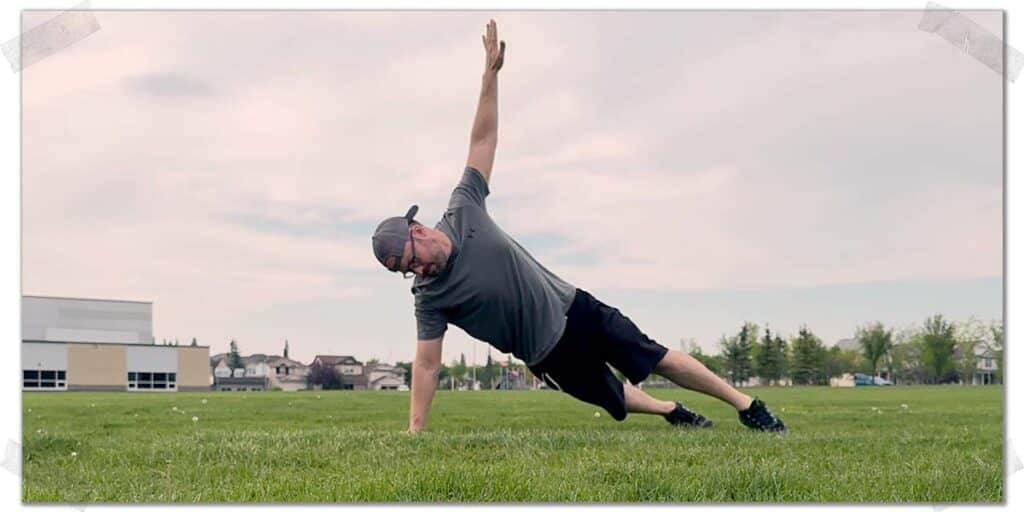
When you travel, you may not have access to the usual fitness training equipment you’d otherwise have at home, but you’ll always have your body weight. And the good news is that you can perform bodyweight training and callisthenics exercises in ways that challenge your strength, endurance, and even your cardiovascular health.
Here are a couple of simplistic examples:
- If you’re used to performing heavy bench press in the gym, trying to crush out fifty unbroken (zero pauses at any point) push-ups in your hotel room will be an adequate shock (and effective muscle stimulus) to your pectoral, anterior deltoid, and triceps muscles.
- If you’re used to performing high-intensity bike rides, try banging out one-hundred unbroken bodyweight squats while throwing in some occasional jump squats for good measure. It will, of course, be a different stimulus than what your body will be used to, but it will absolutely get your legs burning and heart rate pumping.
Related article: FREE Beginner’s Program to Bodyweight Exercise (Three Month Program)
The above examples are quite conceptual, mind you, but they serve a point: you can easily find ways to challenge your body to maintain (if not improve) your fitness using nothing other than you’re body. Sure, it might be a bit tricky (physically or mentally) to do for weeks on end, but if you’re only out of town for a week or so, you’ll be just fine with switching to bodyweight training for the time being.
“Remember, complexity is often the enemy when getting an effective workout (either at home or when on the road). Simplicity can be a powerful strategy, especially for workouts.”
Pro tip: If you need a bit more than just body weight, you can often make do with items in your hotel room, such as a chair for Bulgarian split squats or bent-knee hip bridges. Sometimes, you just need to get creative.
Trust me, no matter how strong or fit you might be or how advanced your training routine is, you’re never too good for bodyweight exercises to provide a healthy stimulus to your body.
Tip 4: Don’t let your diet go on vacation

Whether it’s work-related travels or a personal vacation, just because you’re changing up your location doesn’t mean you have to change up your general dietary intake as well.
Granted, it might not be completely possible to keep your diet exactly the same, but there’s a difference between a mildly less-than-ideal diet when travelling and one that falls off the rails entirely.
You can’t out-train a bad diet, and the only thing worse than losing your fitness progress (from not training) is to stack a lousy diet on top of it. It may not be reasonable to stay entirely on point with your meals while travelling, but making a conscious effort to keep your diet on track can help to offset any cosmetic or physical performance losses you might otherwise experience if unable to perform any fitness-related physical training while away on your trip.
To be clear, it will likely take extra effort on your part, but it will go a long way in ensuring you minimize any losses or regression you may experience when travelling.
Also, to get the most out of this tip, be sure to pair this concept up with tip 8 of this article, which will help even more!
Tip 5: Change up your training for your trip
This tip is similar to tip 3, where I implied the importance of being mentally flexible with your training mode while you’re away on your trip. If you can keep your training identical, or at least similar, to your training back home, awesome!
“It’s ok to change things up for a week or two. Unless you’re preparing for a bodybuilding/fitness/physique show within the next month or two, you’ve got nothing to worry about; your body will manage just fine with a different stimulus, so long as you challenge yourself with an ideal intensity and frequency.”
However, this isn’t always practical. And while modifying your style of training while you’re away might not be your preference, it likely beats the alternative of stressing about finding ways to keep your training otherwise unchanged.
If you’re used to performing resistance training, but don’t have access to your ideal resistance training equipment, rather than waste precious energy worrying about what you’ll do, give your body a week or two (or however long your trip may be) of exposure to a new training method.
RELATED CONTENT:
This can include incorporating the strategy I mentioned in tip 3, where you make heavy use of callisthenics and other bodyweight exercises. The point of this tip, however, is to embrace a different style of training altogether, if needed, rather than try to mirror as much of your typical training style as possible.
It’s ok to change things up for a week or two. Unless you’re preparing for a bodybuilding/fitness/physique show within the next month or two, you’ve got nothing to worry about; your body will manage just fine with a different stimulus, so long as you challenge yourself with an ideal intensity and frequency.
Tip 6: Keep your workouts short, sweet, and intense
The more complex, lengthy, and involved your regular fitness routine is, the more of a hassle it’s going to be when trying to adhere to the same complexities and intricacies of your hometown training when travelling. You likely don’t have access to the same equipment, you may have jet lag that has thrown off your energy, etc.
Remember, complexity is often the enemy when getting an effective workout (either at home or when on the road). Simplicity can be a powerful strategy, especially for workouts.
Besides, if you’re on vacation or on a busy business trip, the last thing you want is to spend your precious time performing lengthy, drawn-out workouts (you can do that when you get back home!).
And if you think you can’t get an effective workout completed in a handful of minutes, think again!
A simple full-body circuit using only your body weight or a Tabata style can provide a hefty physical challenge in only a matter of minutes. If you’re after a quick, full-body routine that challenges your endurance and general fitness, consider trying any of the following Tabata routines.
Pro tip: A Tabata routine consists of eight rounds of all-out exertion for twenty seconds with ten-second breaks between rounds. The whole routine last four minutes and is only as tiring as you make it to be. The goal is to push yourself as hard as possible for each of the eight rounds you perform.
Tabata bodyweight routine: Burpees (can likely be done in your hotel room). As you tire out, you can regress to burpees without jumps, without push-ups, or even regress all the way to bodyweight squats.
Tabata upper body routine: Push-ups (regress to push-ups from knees as you tire out). This can also be done in your hotel room.
Tabata full body dumbbell routine: Dumbbell thrusters (squat to overhead press in one continuous movement).
Regarding the last dumbbell routine, you’ll need access to a couple of lightweight dumbbells (you won’t need to go heavy at all, trust me). Any hotel gym or facility that dares claim to have a gym or fitness facility will have lightweight dumbbells, so these should be very easy to access. Nonetheless, you can always fall back on the bodyweight Tabata routines if needed.
One all-out Tabata routine is usually enough to get a nice little stimulation in for the day. If desired, you could do more than one routine. The point is, when done correctly, it doesn’t take much (aside from brief, intense effort) to get some effective metabolic conditioning in while you’re travelling.
Tip 7: Practice dietary fasting
Circling back to the nutrition realm, this tip is all about optimizing your diet when a lack of adequate dietary options abounds. Any time I find myself in these scenarios, I often skip meals for specific times of the day, particularly those when I know I will either be surrounded by less-than-ideal options or when I’ll be extremely busy.
This type of fasting (often called intermittent fasting) has a host of positive health benefits associated with it, and unless you have an underlying medical or dietary condition, you’ll be just fine if you sit with the discomfort of mild hunger for a handful of hours.
“You can’t out-train a bad diet, and the only thing worse than losing your fitness progress (from not training) is to stack a lousy diet on top of it.”
No, you don’t have to worry about going catabolic or watching your hard-earned muscle waste away. Eat a couple of meals a day with adequate protein, carbs, and fats, and you’ll be just fine—just learn to tolerate the mild hunger in between.
Pro tip: I love practicing intermittent fasting just as much for the mental strength it provides as it does for the physical changes it can bring to the body.
If you want to read up on some of the benefits of intermittent fasting, check out the scientific articles below:
Article 1: Intermittent Fasting And Human Metabolic Health (NIH article)
Article 2: Intermittent Fasting: Is the Wait Worth the Weight? (NIH article)
Tip 8: Plan ahead & do your research before leaving
If you absolutely must keep your weightlifting or physical training regimen as unaltered as possible (which can often be the case), it’s a wise idea to scout out the area you’ll be travelling to before you’re actually there.
Hopping on the internet and finding a local gym, training facility, or grocery store that meets your training or dietary needs and is close to where you’ll be staying can save you a ton of time and energy in the long run. Whether it’s a yoga studio, a spin studio, a swimming facility, etc., a quick online search to see what’s in the area where you’ll be staying can save you from major headaches. The same applies to grocery stores and restaurants that meet your dietary needs.
Fun fact: I’ve had multiple friends over the years who have picked their hotel location based on its proximity to the gym or fitness facility they’ll need to train at while away on their business or personal travels.
It can even be as simple as checking out the amenities of the hotel or place(s) you’ll be staying at as you travel in order to see if they have an ideal gym or training studio that can meet your needs.
Tip 9: Hotel amenities—use them
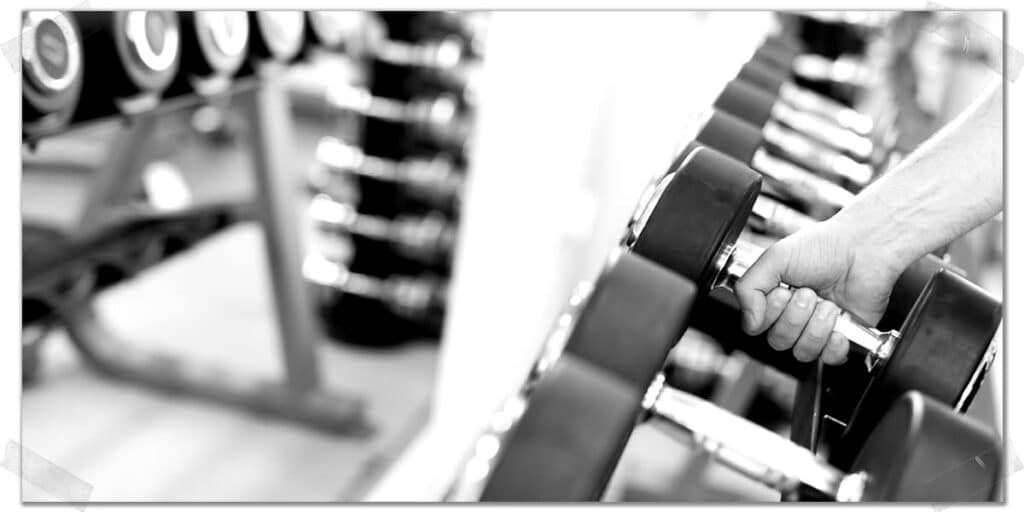
This is a rather straightforward tip, but if you’re staying at a hotel, it bears mentioning. Hotels often have various amenities that guests can use, which can range from gyms and recreation centres to swimming pools and saunas. If you’re staying at a hotel with any of these features, consider using them.
Sure, the hotel gym might not be all that expansive, and the pool (if there is one) might not be big enough to swim laps in, but something is better than nothing. Even a basic gym provides enough open space for bodyweight exercises, stretches, and other similar activities, and a pool can be used for various types of Aquasize or hydrotherapy.
Pro tip: Don’t have a gym at the hotel you’re staying at? Try walking or running up and down the stairwell (particularly a stairwell that isn’t very busy). If you’re staying at a hotel that has multiple stories to it, you can absolutely get in a great stair climbing or stair running workout.
Tip 10: Explore new areas around town
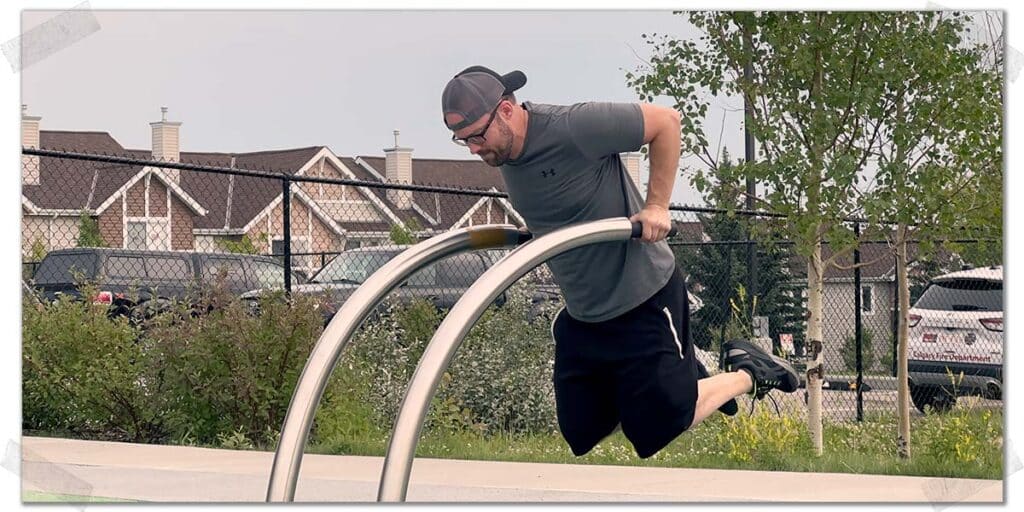
I always consider this to be a fun strategy to implement, particularly when travelling to a new location that I haven’t yet visited.
The whole premise of travelling is to head to a location different than your own. As such, it’s worth experiencing the new sights and sounds, weaving any of your physical training or exercises into this new environment accordingly.
Not only will you get to keep up with your fitness, but you’ll also get to take in new sights and sounds while making new memories in the process. Granted, this strategy works best for warm climates and summertime weather. If you’re travelling to a cold location in the winter, this tip may not apply to you.
Here are some practical examples of what this can look like:
Example 1: Running while exploring
Whether running is part of your training routine or not, you might want to plan a short exploration or venture around town and combine it with a run or brisk walk. Not only will it likely be much more enjoyable than running on the hotel gym’s treadmill (and certainly a lot better than doing nothing at all!), but it will also allow you to see new sights and sounds while getting your sweat on.
Even just physically walking and exploring new parts of the place you’re in (as opposed to riding in a vehicle everywhere) is a great way to burn off extra calories, keep your body moving, and maintain your fitness while not in your hometown.
Example 2: working out in a park
If the hotel or area where you’re staying doesn’t have a gym or any type of fitness facility, performing a fitness session (callisthenics, sprints, stretching, etc.) in a nearby park might be a good option. This is something I have done numerous times over the years.
Spending time in a new park can provide a way to take in the sights and sounds and provide the open space (and even equipment) for challenging exercises.
Common items in the park that can often be useful for workouts include:
- Park benches (useful for incline push-ups, box jumps, Bulgarian split squats, etc.)
- Sets of stairs (useful for stair jogging or stair sprinting)
- Hills (useful for the same concept as stairs)
Pro tip: An empty playground can be a gold mine for improvised training sessions. I’ve utilized playground equipment for various exercises over the years, such as monkey bars for pull-ups and chin-ups, attachments for my TRX trainer, playground equipment for mobility training, and more! (Just be sure you’re being mindful of the little kiddos if there are any around, of course!)
Final thoughts
You might not be able to stay in perfect rhythm with your fitness routine or training when leaving for a trip, but there’s not much excuse to let things fall by the wayside entirely. Typically, if you’re serious about finding ways to maintain (or even continue to improve) your overall physical fitness while away on a trip, you can find all sorts of ways to make it happen.
Get creative, utilize multiple strategies, and be mentally flexible with adapting to the conditions of your trip and what’s around you. If you can do this, you’ll be just fine when it comes to keeping up with your fitness when leaving for a trip, be it for personal or professional reasons.
Frequently Asked Questions
To be as helpful to my readers as possible, I’ve included a few brief answers below for similar fitness-based questions individuals often have when it comes to travelling. I hope they’re insightful and helpful to you!

Hi! I’m Jim Wittstrom, PT, DPT, CSCS, Pn1.
I am a physical therapist who is passionate about all things pertaining to strength & conditioning, human movement, injury prevention and rehabilitation. I created StrengthResurgence.com in order to help others become stronger and healthier. I also love helping aspiring students and therapists fulfill their dreams of becoming successful in school and within their clinical PT practice. Thanks for checking out my site!

